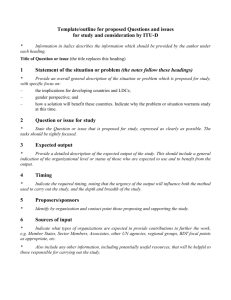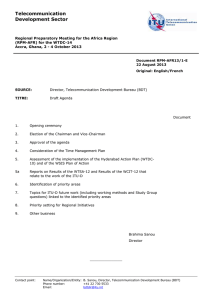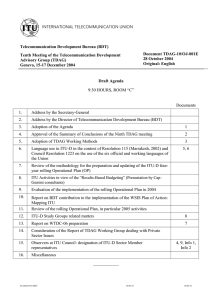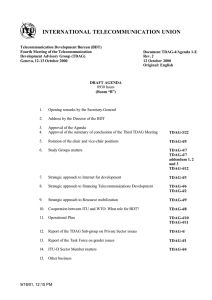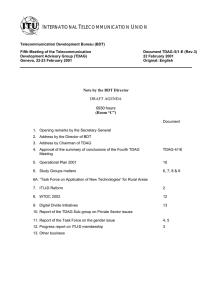I T U
advertisement
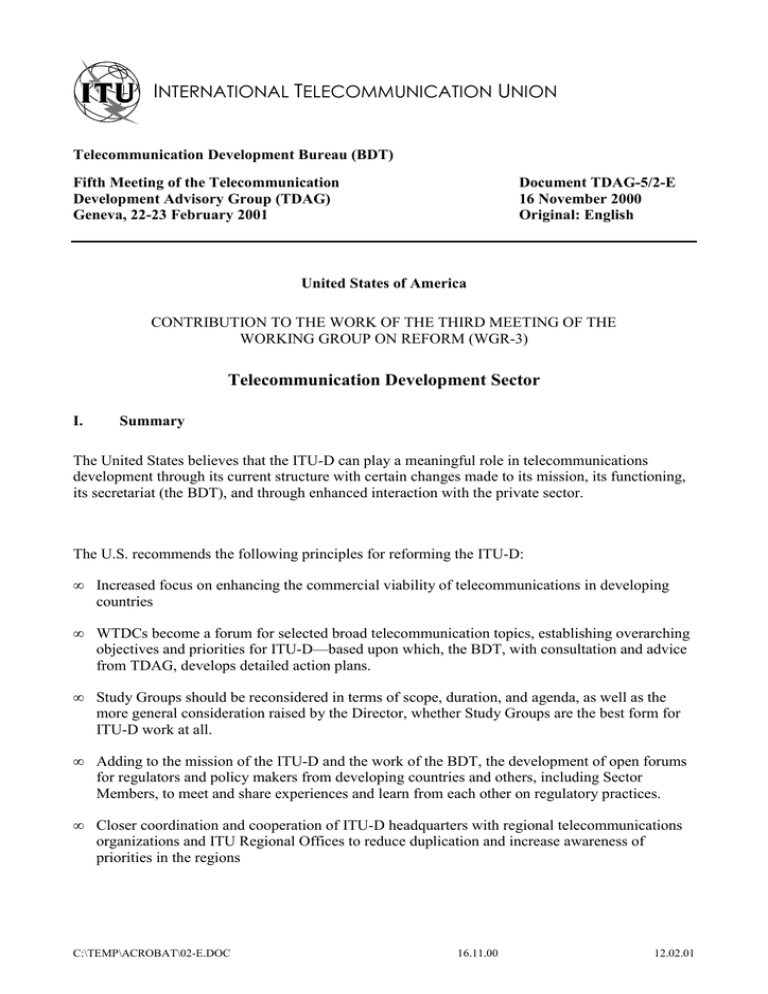
INTERNATIONAL TELECOMMUNICATION UNION Telecommunication Development Bureau (BDT) Fifth Meeting of the Telecommunication Development Advisory Group (TDAG) Geneva, 22-23 February 2001 Document TDAG-5/2-E 16 November 2000 Original: English United States of America CONTRIBUTION TO THE WORK OF THE THIRD MEETING OF THE WORKING GROUP ON REFORM (WGR-3) Telecommunication Development Sector I. Summary The United States believes that the ITU-D can play a meaningful role in telecommunications development through its current structure with certain changes made to its mission, its functioning, its secretariat (the BDT), and through enhanced interaction with the private sector. The U.S. recommends the following principles for reforming the ITU-D: • Increased focus on enhancing the commercial viability of telecommunications in developing countries • WTDCs become a forum for selected broad telecommunication topics, establishing overarching objectives and priorities for ITU-D—based upon which, the BDT, with consultation and advice from TDAG, develops detailed action plans. • Study Groups should be reconsidered in terms of scope, duration, and agenda, as well as the more general consideration raised by the Director, whether Study Groups are the best form for ITU-D work at all. • Adding to the mission of the ITU-D and the work of the BDT, the development of open forums for regulators and policy makers from developing countries and others, including Sector Members, to meet and share experiences and learn from each other on regulatory practices. • Closer coordination and cooperation of ITU-D headquarters with regional telecommunications organizations and ITU Regional Offices to reduce duplication and increase awareness of priorities in the regions C:\TEMP\ACROBAT\02-E.DOC 16.11.00 12.02.01 - 2– TDAG-5/2E • A review of the management of the BDT with a view towards increasing its efficiency, responsiveness, and openness to new ideas from staff or members • A reworking of appropriate products and services of the BDT in order to provide better value to the private sector in terms of matching private sector approaches with developing countries’ priorities • Enhanced interaction with the private sector, including broader integration of the private sector in ITU-D/BDT action plans and operational plans C:\TEMP\ACROBAT\02-E.DOC 16.11.00 12.02.01 - 3– TDAG-5/2E II. Overview This contribution constitutes the views of the U.S. regarding reform of the D-Sector of the ITU in the context of the ITU Reform initiative. The overall ITU Reform process is being carried out by the Working Group on Reform (WGR) of the ITU Council in its implementation of Resolution 74 of the 1998 Plenipotentiary. The general view of the U.S. regarding reform of the D-Sector and its associated secretariat, the Bureau of Telecommunications Development (BDT) is that the mission and activities of ITU-D and the BDT should be increasingly oriented towards the development of sustainable telecommunications systems in developing countries with broad-based involvement of the private sector in action plans and operational plans developed for the ITU-D and the BDT. This can lead to increased interest in ITU-D work by the private sector from developed and developing countries. In this way, the ITU can be a meeting place for private sector from around the world to share ideas and develop mutually beneficial relationships. This should be accomplished while preserving some of the traditional roles of ITU-D, including that of providing direct technical assistance—when appropriate. In promoting sustainable telecommunications development, the BDT needs to play a catalytic role in encouraging sector reform, technology awareness, human resources development, management skill development, business development, and emergency preparedness. In addition, the U.S. believes that the ITU-D is an ideal setting for regulators and policy makers from around the world to meet and share information and ideas on regulatory practices and policy priorities. While we are firmly opposed to developing the ITU or any part of the ITU into anything approaching a “global regulator,” the U.S. believes that there is a need for meaningful interaction among regulators and policy makers—especially for the benefit of developing countries. The U.S. further believes that the ITU-D is the ideal setting within the ITU for regulators, policy makers, and Sector Members from around the world to meet in open meetings and share information and experiences. While the U.S. has a number of comments related to the functioning of the ITU-D and the BDT, we do not foresee the need for any structural changes or any changes to the Constitution or Convention. III. The ITU-D Mission As articulated in the ITU’s Constitution, the ITU-D has a dual responsibility in promoting telecommunications development. It carries out programs developed through the Plenipotentiary Conferences and through the World Telecommunication Development Conferences that aim to promote telecommunications development. The ITU-D also acts as an executing agency for the implementation of projects of United Nations development programs or other funding sources. C:\TEMP\ACROBAT\02-E.DOC 16.11.00 12.02.01 - 4– TDAG-5/2E As reflected in the ITU Strategic Plan, the programs of ITU-D covers five major areas of telecommunications development: sector reform, technologies, management, finance, and human resources. U.S. Recommendations: 1. The mission of the ITU-D should be expanded to focus greater attention on development of sustainable telecommunications systems in developing countries, with broad-based private sector involvement integrated into the actions plans and operational plans developed for ITU-D and the BDT 2. The mission of the ITU-D should be expanded to include acting as an open and effective forum for regulators and policy makers, with involvement of Sector Members, to exchange information and ideas on regulatory practices and policy priorities of particular relevance to developing countries. 3. The mission of the ITU-D should be enhanced in order to take into consideration priorities developed through regional telecommunications organizations in coordination with ITU Regional Offices on matters of particular interest to developing countries. IV. Functioning of the ITU-D As specified in the ITU Constitution, the ITU-D functions through World Telecommunication Development Conferences, Telecommunication Development Study Groups, the Telecommunication Development Advisory Group, and the BDT itself. U.S. Recommendations: 1. Consideration should be given to recasting the WTDCs to be more topical in nature, in order to develop overarching objectives and priorities upon which the BDT may rely in developing a work program that is practical and focuses on strategies that will help developing countries evolve their telecommunications sectors to be more oriented towards viable and sustainable systems. The traditional role of the WTDC, developing a four-year Action Plan to provide programmatic guidance to the BDT, does not provide the flexibility needed in today’s changing environment. Instead, the WTDC should establish overarching objectives and priorities, leaving development of specific work programs, goals, and action plans to the BDT in consultation with TDAG. 2. Consideration should be given to adding an educational/informational aspect to the WTDC to provide attendees with practical information regarding the application of technology. 3. As the Director has suggested, the ITU-D study group structure should be reevaluated for its appropriateness to the work and goals of ITU-D. Study Groups should be evaluated from different perspectives, including format, duration, output, etc. Alternative formats, such as roundtables, break-out sessions, workshops, and seminars may provide more useful opportunities for sharing ideas and information. Careful consideration should be given to what type of output would have the most constructive impact. 4. Consideration should be given to holding study group and other meetings in locations other than Geneva. Holding them in the regions--especially if the topic is of particular concern or interest to a specific region--might allow for easier participation by developing countries in the most relevant region. These meetings might be held in ITU Regional Offices, in conjunction with the relevant regional telecommunications organization, in order to avoid duplication of effort, C:\TEMP\ACROBAT\02-E.DOC 16.11.00 12.02.01 - 5– TDAG-5/2E enhance participation in both, strengthen ITU’s regional presence, and stimulate synergy between the regional organization and ITU. 5. TDAG agendas should provide opportunities for Member States and Sector Members to provide practical and strategic input into the development of programs for the BDT consistent with 1) above. Telecommunication Development Bureau—The U.S. encourages ongoing improvements in BDT structure and management (see Council ’00), and observes that continuing improvement in the following areas would have positive effects on management of the staff, delivery of services to members, and effective implementation of programs and projects. 1. Management • Team approach to projects • Streamlining and flattening of management structure • Use of accountability/incentive management processes • Maximal usage of technology such as web-based training for developing country officials 2. BDT products and services • Reevaluate all products and services from the perspective of membership demand • Refocus products and services towards promotion of sustainable telecommunications systems in developing countries • Group and package products and services in a way that makes clear to Sector Members the value of ITU-D participation to industry • • Increase awareness and visibility of BDT and ITU-D products and services Consider establishment of a BDT newsletter/magazine (electronic or hard copy) that touts achievements and value of BDT programs to industry and to developing countries 3. Develop the ITU-D to include an open international forum for regulators, policy makers, and Sector Members from around the world to share ideas and experiences on regulatory practices and policy priorities, focusing especially on the needs and concerns of developing countries. 4. Operational plan • Add medium-term and short-term goals, with measurable milestones, for the BDT overall • Establish an efficient process for developing priority actions; incorporate input from the Regional Offices, especially as developed in coordination with regional telecommunications organizations, and from headquarters • Develop operational plan in a timely way, to allow for TDAG and Council review for subsequent year 5. Understand and utilize the synergy between the BDT and the other two Bureaus as well as the General Secretariat C:\TEMP\ACROBAT\02-E.DOC 16.11.00 12.02.01 - 6– TDAG-5/2E • When appropriate, take advantage of scheduled meetings of T and R Sectors and General Secretariat to add a development component • At scheduled ITU-D meetings, promote the interests of T and R Sectors and General Secretariat, when appropriate • Collaborate with staff of the T and R Sectors and the General Secretariat to evaluate the potential of joint work teams for specific initiatives 6. Survey the ITU-D membership and BDT staff annually for possible new initiatives that fulfill the mandate of the BDT V. Relations with the Private Sector The ITU-D is comprised of Member States and Sector Members. There are over 200 Sector Members, most of which are from the private sector. These companies and organizations interact with the activities and initiatives of the BDT in a variety of ways. Input from the private sector comes through various means, including formally through the Subgroup on the Private Sector of TDAG. Despite these various mechanisms for input and participation, the interest in the work of the ITU-D by the private sector waxes and wanes. The BDT and developing countries need to better involve the private sector so that through combined effort, the needs of developing countries can be met and commercially sustainable services developed. U.S. Recommendations: 1. Consider ways to more broadly incorporate the private sector into the action plans and the operational plans of the ITU-D and BDT 2. Consider how best to increase the effectiveness of, and participation in, the Subgroup on the Private Sector. The Subgroup was developed at a time when there was no open Advisory Group to the BDT Director. The establishment of TDAG changes the situation in ways that encourage a reevaluation of the Subgroup and its relationship with TDAG and the BDT Director. 3. Consider mechanisms that promote membership and participation by industry in the ITU-D. ________________ C:\TEMP\ACROBAT\02-E.DOC 16.11.00 12.02.01
